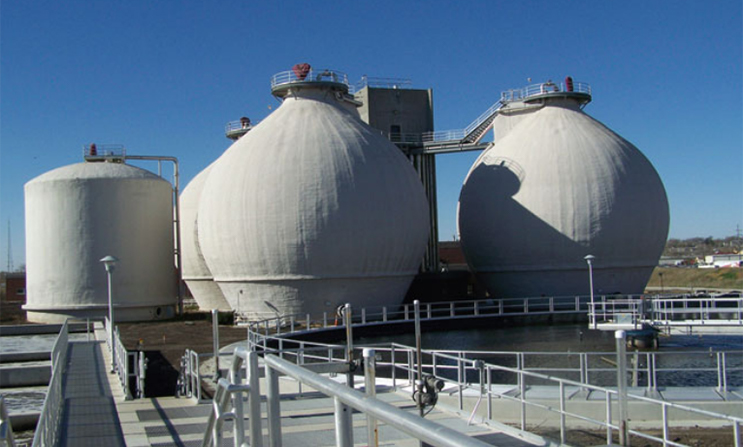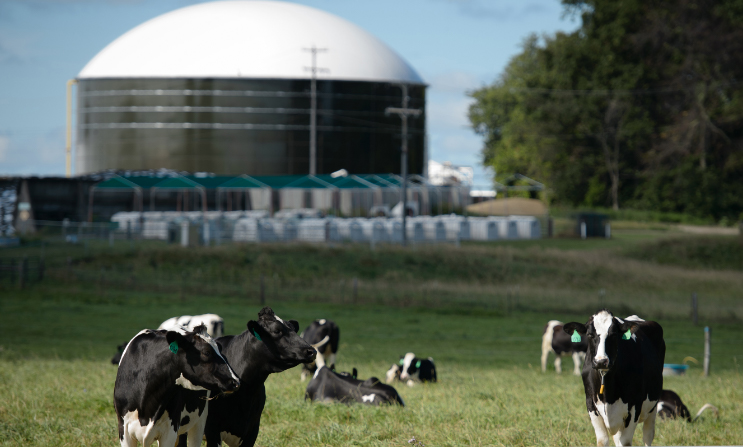Biogas from biomass
Biogas, which may be called renewable natural gas (RNG) or biomethane, is an energy-rich gas produced by anaerobic decomposition or thermochemical conversion of biomass. Biogas is composed mostly of methane (CH4) (the main compound in fossil natural gas) and carbon dioxide (CO2). The methane content of raw (untreated) biogas varies from 45%–65%, depending on the material (feedstock) used to produce the biogas. Raw biogas can be burned directly as a fuel for heating or for generating electricity for onsite use or for sale to the electric power grid. Raw biogas must be treated to produce RNG before it can be used in place of fossil natural gas. RNG can be used to produce compressed natural gas (CNG) or it can be injected into natural gas pipelines. RNG treatment includes removing moisture and reducing nitrogen; CO2; and trace amounts of siloxanes, volatile organic compounds, and hydrogen sulfide. The resulting RNG has a methane content of at least 90%. RNG injected into natural gas pipelines has a methane content of 96%–98%.
Anaerobic decomposition of biomass occurs when anaerobic bacteria—bacteria that live without the presence of free oxygen—eat and break down, or digest, biomass and produce biogas. Anaerobic bacteria occur naturally in soil, in bodies of water such as swamps and lakes, and in the digestive tracts of humans and animals. Biogas forms in and can be collected from municipal solid waste landfills and livestock manure holding ponds. Biogas can also be produced under controlled conditions in special tanks called anaerobic digesters. Digestate, the material remaining after anaerobic digestion is complete, is rich in nutrients and can be used as a fertilizer.
Biomass can be converted to a gas through gasification. The U.S. Department of Energy supports research on biomass gasification for hydrogen production.
Most of the biogas consumed in the United States is produced from anaerobic decomposition and is used for electricity generation. Biogas qualifies as a renewable fuel for electricity generation in some state renewable portfolio standards. It also qualifies under the U.S. Renewable Fuel Standard Program as an advanced or cellulosic biofuel and under California’s Low Carbon Fuel Standard as a feedstock for low carbon fuels. On June 21, 2023, the U.S. Environmental Protection Agency (EPA) announced a final rule that established biofuel volume requirements and standards for cellulosic biofuel for 2023–25 as part of the RFS program. The cellulosic biofuel category primarily applies to RNG. RNG is fully interchangeable with fossil-based natural gas and can be injected into natural gas pipelines or used to fuel natural gas vehicles.
Collecting and using biogas from landfills
Landfills for municipal solid waste are a source of biogas. Biogas is produced naturally by anaerobic bacteria in municipal solid waste landfills and is called landfill gas. Landfill gas with a high methane content can be dangerous to people and the environment because methane is flammable. Methane is also a strong greenhouse gas. Biogas contains small amounts of hydrogen sulfide, a noxious and potentially toxic compound when in high concentrations.
In the United States, regulations under the Clean Air Act require municipal solid waste landfills of a certain size to install and operate a landfill gas collection and control system. Some landfills reduce landfill gas emissions by capturing and burning—or flaring—the landfill gas. Burning the methane in landfill gas produces CO2, but CO2 is not as strong a greenhouse gas as methane. Many landfills remove moisture, siloxane, and sulfur from the biogas to generate electricity and some treat the biogas further to produce RNG.
Biogas from sewage and industrial wastewater treatment
Many municipal sewage treatment plants and manufacturers, such as paper mills, food processors, and breweries, use anaerobic digesters as part of their waste treatment processes. Some sewage treatment plants and industrial facilities collect and use the biogas produced in anaerobic digesters to heat the digesters, which enhances the anaerobic digestion process and destroys pathogens. Some facilities use biogas to generate electricity to use at the facility or to sell to the electric power grid.
Using biogas from animal waste
Some dairy farms and livestock operations use anaerobic digesters to produce biogas from manure and from used bedding material from their barns. Some livestock farmers cover their manure holding ponds (also called manure lagoons) to capture the biogas that forms in the lagoons. The methane in the biogas can be burned to heat water and buildings and to generate electricity for the farm in diesel-engine generators.
1 Utility-scale power plants have at least 1 megawatt (1,000 kilowatts) of electricity generation capacity.
Last updated: November 19, 2024.



